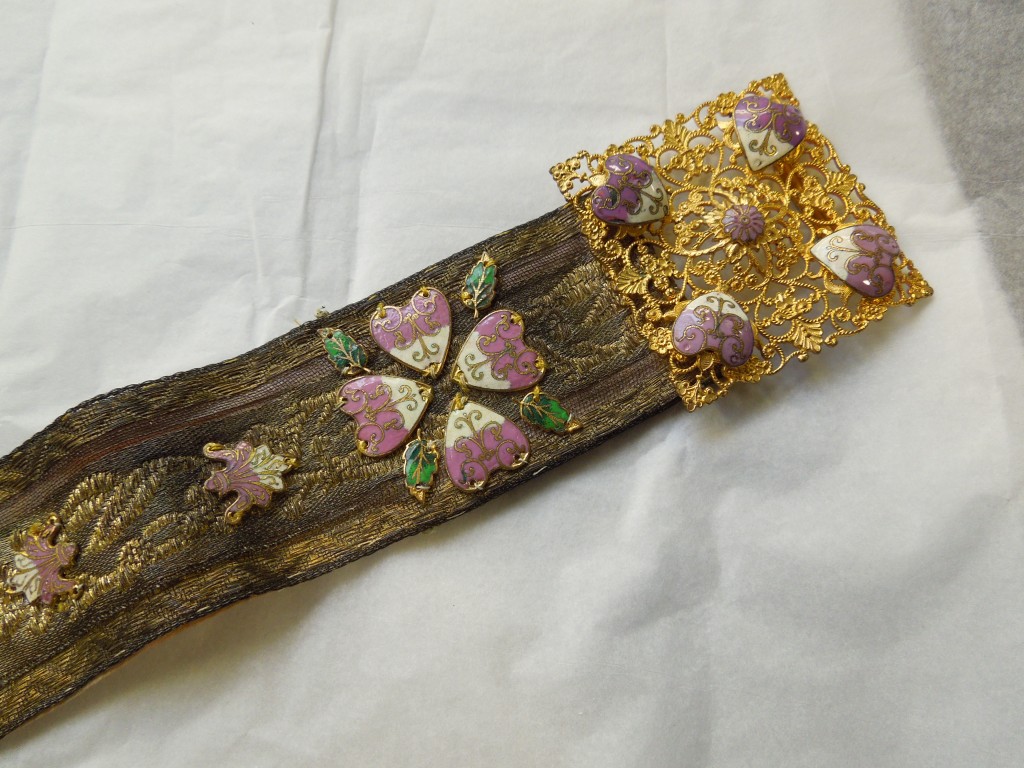The CRC has recently acquired a rare belt previously owned by a Scottish suffragette. The belt has already been attracting lots of interest on Twitter so we’ve been exploring where it sits in the context of Suffragette textiles and symbolism.
 The belt is made from a strip of ribbon, embroidered with enamelled motifs in the signature white, green and purple associated with the suffrage movement. It has a pink lining on the reverse and a gilt buckle fastening. The belt is in amazing condition despite some oxidisation of the silver in the ribbon, leading the silver threads to turn dark grey.
The belt is made from a strip of ribbon, embroidered with enamelled motifs in the signature white, green and purple associated with the suffrage movement. It has a pink lining on the reverse and a gilt buckle fastening. The belt is in amazing condition despite some oxidisation of the silver in the ribbon, leading the silver threads to turn dark grey.


The belt is a bit of mystery that we hope to explore in more depth. Its provenance suggests it was worn in Edinbugh at the Suffragette procession on 9 October 1909, organised by the WSPU (Women’s Social and Political Union). It is not clear if it is was bought at one of the many department stores which catered to the political movement, or if it was homemade (visible stitching on the reverse suggests some element of home alteration). We know that London department stores, such as Selfridges & Co and Derry & Toms, responded to consumer demand by stocking items in green, white and purple, even taking out adverts in the WSPU newspaper Votes for Women (Parkins 2002: 100, 102). It would be interesting to see which, if any, Scottish stores and haberdashery shops followed suit.


The integration of emblematic colours into everyday dress seems a simple and effective way of showing one’s commitment to a cause. However recent research by scholars such as Wendy Parkins and Eileen Wheeler has also highlighted the important role that fashion and textiles had in removing the traditional division between the ‘home’ and ‘public’.
The wearing of the WSPU colours of purple, white and green, for instance… allowed women to construct practices of conventional femininity as political and to understand themselves as political subjects whether in the home, shopping, or protesting on the streets. In this way, apparently fixed demarcations between politics, fashion and consumption were unsettled and reconfigured by the suffragettes. (Parkins 2002: 100)
In using silk and velvet associated with the drawing room and working in embroidery and applique associated with the feminine, they succeeded in using amateur craft identified with a chaste and domestic femininity to mount a political challenge that sought short term political gain and long term social change. (Wheeler 2012: 5)
 The belt is a really exciting addition to our collections, providing a material culture viewpoint from which to explore this important political movement. It will be taking its place in the Art Collection, and complements the items relating to women’s suffrage in the archive and rare books collections.
The belt is a really exciting addition to our collections, providing a material culture viewpoint from which to explore this important political movement. It will be taking its place in the Art Collection, and complements the items relating to women’s suffrage in the archive and rare books collections.
Sources:
Wendy Parkins, ‘The Epidemic of Purple, White and Green: Fashion and the Suffragette Movement in Britain 1908-14’, Fashioning the Body Politic: dress, gender, citizenship. Oxford: Berg, 2002, pp97-124. Find it on DiscoverEd
Eileen Wheeler, ‘The Political Stitch: Voicing Resistance in a Suffrage Textile’, Textile Society of America Symposium Proceedings. Textile Society of America, 2012, Paper 758. Access Online
Related Items in the Collections:
Letter from Christabel Pankhurst to Mrs Morrow, 23 November 1913, E2013.35. Archives Catalogue Description
The Suffragette: the history of the women’s militant suffrage movement, 1911. London: Gay & Hancock Ltd. Find it on DiscoverEd
Fran Baseby, CRC Services Manager, fran.baseby@ed.ac.uk

Fascinating item, I’d love to see it.
Hi Michelle,
So glad you’ve enjoyed hearing about it. We’re hoping to get the belt on display some time soon, however if you’d like to see it soon you can put a request through is-crc@ed.ac.uk and we’ll see if we can accommodate it.
Fran
Pingback: The Gloves Are Off! | To Protect and (Con)serve
nice article. May I share this?
Yes, you are welcome to
Pingback: Feminism in stitches. - Emma Cownie Artist